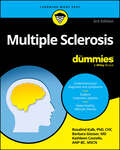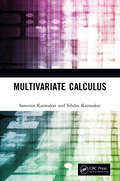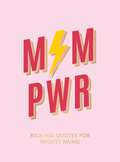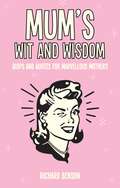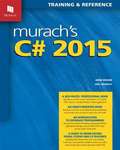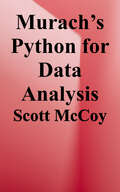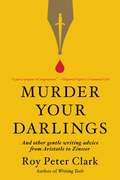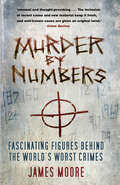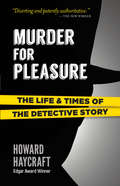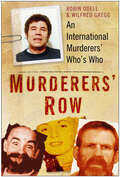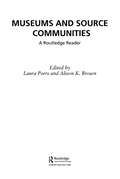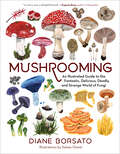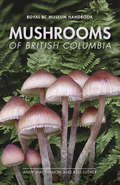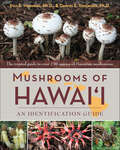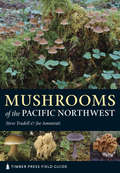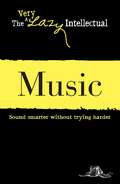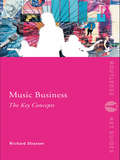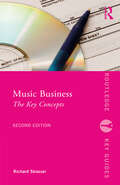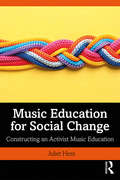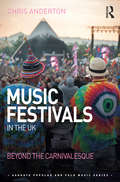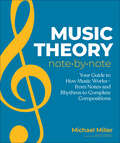- Table View
- List View
Multiple Sclerosis For Dummies
by Rosalind Kalb Barbara Giesser Kathleen CostelloEveryone's MS is different—learn the best way to manage yours Multiple sclerosis (MS) is a chronic, unpredictable autoimmune disease that affects millions of people worldwide. It poses unique challenges for people with MS and their care partners because the symptoms (many of which are invisible to others) are so variable from day to day and month to month. Multiple Sclerosis For Dummies helps you and your loved ones understand the importance of early treatment and become familiar with all of the latest treatment options and therapies. You aren't alone—this compassionate guide includes resources for connecting with the right MS care provider, building a care team, managing your emotions and stress, and getting the support you need. Plus, you'll get tips for making lifestyle choices that help you along your MS path. Discover information on the latest diagnostic information, treatments, and symptom management strategies Learn why it's so important to take care of your mental health and emotional wellbeing as you treat your MS Get pointers for talking to MS care providers and your loved ones, advocating for yourself, and making decisions alongside your care team Find trustworthy books, websites, and community resources to expand your knowledge and improve your health Multiple Sclerosis For Dummies is a great starting point for anyone facing a new MS diagnosis or looking for updated information. Partners and family members will also learn how to care for themselves while caring for the person they love.
Multivariate Calculus
by Sibdas Karmakar Samiran KarmakarThis book is a compilation of all basic topics on functions of Several Variables and is primarily meant for undergraduate and post graduate students. Topics covered are: Limits, continuities and differentiabilities of functions of several variables. Properties of Implicit functions and Jacobians. Extreme values of multivariate functions. Various types of integrals in planes and surfaces and their related theorems including Dirichlet and Liouville’s extension to Dirichlet. Print edition not for sale in South Asia (India, Sri Lanka, Nepal, Bangladesh, Pakistan or Bhutan)
Mum Pwr: Kick-Ass Quotes for Mighty Mums
by Summersdale PublishersAin’t no ’hood like motherhood It’s the hardest job on earth and you do it all fuelled up on nothing but coffee, chaos and cuddles. Let this book of quotes and statements remind you what a freaking badass you are!
Mum's Wit and Wisdom: Quips and Quotes for Marvellous Mothers
by Richard BensonWhen the little angels are driving you crazy and you’re one minivan away from being a personal taxi service, these wonderful quips and quotes will help to remind you that being a mum is the best job in the world.
Mum's Wit and Wisdom: Quips and Quotes for Marvellous Mothers
by Richard BensonWhen the little angels are driving you crazy and you’re one minivan away from being a personal taxi service, these wonderful quips and quotes will help to remind you that being a mum is the best job in the world.
Murach's C# 2015
by Anne Boehm Joel MurachMicrosoft's Visual C# is an elegant, object-oriented language that uses syntax that's similar to C++ and Java. This 2015 edition has been updated throughout to make it easier for you to gain the C# and Visual Studio skills that employers are looking for in today's application developers. This book is for anyone who wants to learn how to use Visual C# 2015 for developing professional Windows Forms applications using Visual Studio 2015 and the .NET Framework. That includes the entire range of developers from complete beginners to experienced Java, C++, and Visual Basic programmers.
Murach's Python for Data Analysis
by Scott McCoyData is collected everywhere these days, in massive quantities. But data alone does not do you much good. That is why data analysis -- making sense of the data -- has become a must-have skill in the fields of business, science, and social science. But it is a tough skill to acquire. The concepts are challenging, and too many books and online tutorials treat only parts of the total skillset needed. <p><p>Now, though, this book draws all the essential skills together and presents them in a clear and example-packed way. So you will soon be applying your programming skills to complex data analysis problems, more easily than you ever thought possible. In terms of content, this book gets you started the right way by using Pandas for data analysis and Seaborn for data visualisation, with JupyterLab as your IDE. Then, it helps you master descriptive analysis by teaching you how to get, clean, prepare, and analyse data, including time-series data. Next, it gets you started with predictive analysis by showing you how to use linear regression models to predict unknown and future values. And to tie everything together, it gives you 4 real-world case studies that show you how to apply your new skills to political, environmental, social, and sports analysis. <p><p>At the end, you will have a solid set of the professional skills that can lead to all sorts of new career opportunities. Sound too good to be true? Download a sample chapter for free from the Murach website and see for yourself how this book can turn you into the data analyst that companies are looking for.
Murder Your Darlings: And Other Gentle Writing Advice from Aristotle to Zinsser
by Roy Peter ClarkFrom one of America's most influential teachers, a collection of the best writing advice distilled from fifty language books -- from Aristotle to Strunk and White.With so many excellent writing guides lining bookstore shelves, it can be hard to know where to look for the best advice. Should you go with Natalie Goldberg or Anne Lamott? Maybe William Zinsser or Stephen King would be more appropriate. Then again, what about the classics -- Strunk and White, or even Aristotle himself?Thankfully, your search is over. In Murder Your Darlings, Roy Peter Clark, who has been a beloved and revered writing teacher to children and Pulitzer Prize winners alike for more than thirty years, has compiled a remarkable collection of more than 100 of the best writing tips from fifty of the best writing books of all time. With a chapter devoted to each key strategy, Clark expands and contextualizes the original author's suggestions and offers anecdotes about how each one helped him or other writers sharpen their skills. An invaluable resource for writers of all kinds, Murder Your Darlings is an inspiring and edifying ode to the craft of writing.
Murder by Numbers: Fascinating Figures Behind the World’s Worst Crimes
by James MooreWhat’s the connection between the number 13 and Jack the Ripper? Why is the number 23 of note in the assassination of Julius Caesar? And what is so puzzling about the number 340 in the chilling case of the Zodiac Killer? The answers to all these questions and many more are revealed in this unique, number crunching history of the ultimate crime.Packed with 100 entries ranging from 1 to 1 billion, Murder by Numbers tells the story of murder in an entirely new way – through the key digits involved. Discover why the length of a bath was critical to convicting a killer, how the weight of a trunk helped police crack a case and why a fake house number was central to a seemingly unfathomable murder mystery. Full of astonishing figures, from fatal doses of poison to grizzly death tolls, this gripping armchair guide also covers scores of famous cases such as the Black Dahlia, Acid Bath Murderer and Yorkshire Ripper. Featuring murders involving Al Capone, Bonnie and Clyde, Neville Heath, Lord Lucan, Ted Bundy, Harold Shipman and even Adolf Hitler, this is a must for true crime addicts, history buffs or anyone who has ever longed to solve a classic ‘whodunit’.
Murder for Pleasure: The Life and Times of the Detective Story
by Howard Haycraft"Genuinely fascinating reading."—The New York Times Book Review "Diverting and patently authoritative."—The New Yorker "Grand and fascinating … a history, a compendium and a critical study all in one, and all first rate."—Rex Stout "A landmark … a brilliant study written with charm and authority."—Ellery Queen "This book is of permanent value. It should be on the shelf of every reader of detective stories."—Erle Stanley Gardner Author Howard Haycraft, an expert in detective fiction, traces the genre's development from the 1840s through the 1940s. Along the way, he charts the innovations of Edgar Allan Poe, Wilkie Collins, and Arthur Conan Doyle, as well as the modern influence of George Simenon, Josephine Tey, and others. Additional topics include a survey of the critical literature, a detective story quiz, and a Who's Who in Detection.
Murderers' Row: An International Murderers' Who's Who
by Robin Odell Wilfred GreggCriminoloogist Robin Odell has compiled this gruesome gallery of cases from all over the world, revealing the growth in serial slayings, contract killings and middle-class murders and investigating what motivates people to commit the ultimate crime. As well as gangsters and ordinary felons, the book includes doctors, millionaries, housewives, children, lawyers, accountants, officers and gentlemen who have succumbed to the killing instinct. Behind the sensational names concocted by the tabloid press - 'Boston Strangler', 'Dracula Killer', 'Night Stalker', 'Granny Killer' - lurk real murderers committing acts of violence in circumstances often more bizarre than fiction.Arranged in an easy-to-use A-Z format, the book contains over 500 cases from serial killers such as Dennis Nilsen and Ted Bundy, to those such as Jeremy Bamber and Steven Benson who dispatched their parents for money; from murderous New Zealand teenagers whose story made a successful film, to the many doctors and nurses who took life instead of saving it; from unsolved murders such as the murder of Little Gregory in France to the paid assignments of John Waynes Hearn, a Vietnam veteran who killed to order. The result is a classic of true crime, a definitive work on murder as a worldwide phenomenon.
Museums and Source Communities: A Routledge Reader
by Alison K. Brown Laura PeersThis volume combines some of the most influential published research in this emerging field with newly commissioned essays on the issues, problems and lessons involved in collaborating museums and source communities. Focusing on museums in the UK, North America and the Pacific, the book highlights three areas which demonstrate the new developments most clearly: the museum as field site or 'contact zone' - a place which source community members enter for purposes of consultation and collaboration visual repatriation - the use of photography to return images of ancestors, historical moments and material heritage to source communities exhibition case studies - these are discussed to reveal the implications of cross-cultural and collaborative research for museums, and how such projects have challenged established attitudes and practices. As the first overview of its kind, this collection will be essential reading for museum staff working with source communities, for community members involved with museum programmes, and for students and academics in museum studies and social anthropology.
Mushrooming: An Illustrated Guide To The Fantastic, Delicious, Deadly, And Strange World Of Fungi
by Diane Borsato“A merry, idiosyncratic guide, charmingly illustrated.”—Eugenia Bone, The Wall Street Journal An illustrated guide to over 100 types of mushrooms, offering insights and stories about these mysterious organisms An incredible diversity of fungi is flourishing all around us, not just in the forest but in parks, markets, and even museums. Once you know how to look, you can find mushrooms named after fairies and demons, mushrooms that look so much like woodland birds they are shot at by hunters, mushrooms that glow in the dark . . . and so much more. Beyond serving as a guide for identification, Mushrooming explores how “the quiet hunt” can radically expand our perspectives, connect us to nature, and enrich our lives. Whether you’re a beginner forager or an expert mycophile, this is the perfect handbook to spark your curiosity and deepen your appreciation for the fantastic, delicious, deadly, and strange world of fungi.
Mushrooms of British Columbia (Royal BC Museum Handbook)
by Kem Luther Andy MacKinnon“This book will expand the pleasure and knowledge of anyone who spends time in nature.”— Robert BatemanWith more species of fungi than any other region in Canada, British Columbia is a rich playground for mushroom hunters. Now there's Mushrooms of British Columbia, the newest handbook from the Royal BC Museum. It's perfect for anyone wanting to know more about BC mushrooms—whether for study, harvest, photography or appreciation.Authors and mushroom experts Andy MacKinnon and Kem Luther bring a practical and playful approach to helping people quickly and confidently identify the mushrooms of British Columbia. Common names trump technical terminology, fungi are grouped by overall shape, and written descriptions of more than 350 common species are reinforced with carefully curated diagnostic images.This is the go-to guidebook for anyone, amateur or expert, who loves to study, draw, photograph and eat BC mushrooms.
Mushrooms of Hawai'i: An Identification Guide
by Dennis E. Desjardin Don E. HemmesHawai'i is known for its verdant mountains and colorful ocean ecosystems, but few realize the depth and range of the islands' mushroom diversity. In fact, Hawai'i is home to over 230 species of mushrooms that are prized by foragers from around the world. In Mushrooms of Hawai'i, Don Hemmes and Dennis Desjardin present a beautiful and comprehensive guide to the treasure trove of mycological life in the Aloha State. Inside you'll find information on Mushroom identification Culinary and medicinal uses of Hawaiian mushrooms Where to find the best mushroom-hunting spots The seasonality of Hawaiian mushrooms And everything else you might need to make your foraging adventure a success. Mushrooms of Hawai'i also includes beautiful illustrations to help you identify familiar treasures like morels, well-known dangers like Amanita muscaria, and exciting species unique to the islands. Whether you're hunting Copelandia cyanescens ("magic" mushrooms) in the pasture grasses high in the mountains of Maui, or foraging for Laetiporus (chicken of the woods), an edible mushroom sought after by foodies for its uniquely delicious taste, this book is the must-have guide for fungophiles.
Mushrooms of the Pacific Northwest: Timber Press Field Guide (A Timber Press Field Guide)
by Joe Ammirati Steve TrudellExplore the heart of mushroom country The Pacific Northwest is one of the best places to find mushrooms—they are both abundant and spectacularly diverse. Yet until now, there has been no mushroom guide that focuses on the region. This compact, beautifully illustrated guide presents descriptions and photographs of 460 of the region's mushrooms. In addition to profiles on individual species, Mushrooms of the Pacific Northwest also includes a general discussion and definition of fungi, information on where to find mushrooms and guidelines on collecting them, an overview of fungus ecology, and a discussion on how to avoid mushroom poisoning.
Mushrooms of the Redwood Coast: A Comprehensive Guide to the Fungi of Coastal Northern California
by Christian Schwarz Noah SiegelA comprehensive and user-friendly field guide for identifying the many mushrooms of the northern California coast, from Monterey County to the Oregon border. Mushrooms of the Redwood Coast will help beginning and experienced mushroom hunters alike to find and identify mushrooms, from common to rare, delicious to deadly, and interesting to beautiful. This user-friendly reference covers coastal California from Monterey County to the Oregon border with full treatments of more than 750 species, and references to hundreds more. With tips on mushroom collecting, descriptions of specific habitats and biozones, updated taxonomy, and outstanding photography, this guide is far and away the most modern and comprehensive treatment of mushrooms in the region. Each species profile pairs a photograph with an in-depth description, as well as notes on ecology, edibility, toxicity, and look-alike species. Written by mushroom identification experts and supported by extensive field work, Mushrooms of the Redwood Coast is an indispensable guide for anyone curious about fungi.From the Trade Paperback edition.
Music
by Adams MediaIs your musical knowledge limited to the Top 40? Have trouble telling the difference between Mozart and Beethoven? Fear not! The Very Lazy Intellectual: Music introduces you to both the world's most influential musicians and the origins of every style of music. With information on everyone from Bach to Nirvana and styles from classical to punk, you'll be jamming in no time.
Music Business: The Key Concepts (Routledge Key Guides)
by Richard StrasserMusic Business: The Key Concepts is a comprehensive guide to the terminology commonly used in the music business today. It embraces definitions from a number of relevant fields, including: general business marketing e-commerce intellectual property law economics entrepreneurship In an accessible A-Z format and fully cross-referenced throughout, this book is essential reading for music business students as well as those interested in the music industry.
Music Business: The Key Concepts (Routledge Key Guides)
by Richard StrasserMusic Business: The Key Concepts, second edition, is a comprehensive guide to the terminology commonly used in the music business today.This updated second edition responds to the music industry's increasingly digital and ever-evolving environment, with definitions from a number of relevant fields, including: general business marketing e-commerce intellectual property law economics entrepreneurship In an accessible A-Z format and fully cross-referenced throughout, this book is essential reading for music business students as well as those interested in the music industry.
Music Education for Social Change: Constructing an Activist Music Education
by Juliet HessMusic Education for Social Change: Constructing an Activist Music Education develops an activist music education rooted in principles of social justice and anti-oppression. Based on the interviews of 20 activist-musicians across the United States and Canada, the book explores the common themes, perceptions, and philosophies among them, positioning these activist-musicians as catalysts for change in music education while raising the question: amidst racism and violence targeted at people who embody difference, how can music education contribute to changing the social climate? Music has long played a role in activism and resistance. By drawing upon this rich tradition, educators can position activist music education as part of a long-term response to events, as a crucial initiative to respond to ongoing oppression, and as an opportunity for youth to develop collective, expressive, and critical thinking skills. This emergent activist music education—like activism pushing toward social change—focuses on bringing people together, expressing experiences, and identifying (and challenging) oppressions. Grounded in practice with examples integrated throughout the text, Music Education for Social Change is an imperative and urgent consideration of what may be possible through music and music education.
Music Festivals in the UK: Beyond the Carnivalesque (Ashgate Popular and Folk Music Series)
by Chris AndertonThe outdoor music festival market has developed and commercialised significantly since the mid-1990s, and is now a mainstream part of the British summertime leisure experience. The overall number of outdoor music festivals staged in the UK doubled between 2005 and 2011 to reach a peak of over 500 events. UK Music (2016) estimates that the sector attracts over 3.7 million attendances each year, and that music tourism as a whole sustains nearly 40,000 full-time jobs. Music Festivals in the UK is the first extended investigation into this commercialised rock and pop festival sector, and examines events of all sizes: from mega-events such as Glastonbury Festival, V Festival and the Reading and Leeds Festivals to ‘boutique’ events with maximum attendances as small as 250. In the past, research into festivals has typically focused either on their carnivalesque heritage or on developing managerial tools for the field of Events Management. Anderton moves beyond such perspectives to propose new ways of understanding and theorising the cultural, social and geographic importance of outdoor music festivals. He argues that changes in the sector since the mid-1990s, such as professionalisation, corporatisation, mediatisation, regulatory control, and sponsorship/branding, should not necessarily be regarded as a process of transgressive 'alternative culture’ being co-opted by commercial concerns; instead, such changes represent a reconfiguration of the sector in line with changes in society, and a broadening of the forms and meanings that may be associated with outdoor music events.
Music Sketches
by Friedemann SallisThe term 'music sketch' relates to the vast variety of documents that are used by composers to work out a musical technique or idea and to prepare their work for performance or publication. These documents can often provide crucial insights into authorship, biography, editorial practice and musical analysis. This Introduction provides students and scholars with the knowledge and skills they need to embark on research projects involving the study of composers' working documents. Presenting examples of the compositional process over a 400-year period, it includes a selection of detailed case studies on how sketches were created and the techniques that were used, such as transcription and the sorting of loose leaves. Numerous illustrations of manuscripts and autographs, many of which have never been published before, show how these vital documents can be used to better understand the compositional processes of the seventeenth and eighteenth centuries.
Music Theory 101: From keys and scales to rhythm and melody, an essential primer on the basics of music theory (Adams 101 Series)
by Marc Schonbrun Brian BooneLearn the basics of music theory in this comprehensive and easy-to-understand guide.From classical to hard rock, and jazz to hip hop, music is constantly evolving, but many of the basics have stayed the same. Understanding these basics is key to becoming a successful musician and well-rounded music lover. Music Theory 101 covers everything novice musicians and lifelong learners need to know, including: -How to read sheet music -Understanding the construction of chords and scales -The different rhythm and time signatures -How keys are identified and organized Full of music trivia, music history, comprehensive instruction, and visual aids of scales, music symbols, and chords throughout, Music Theory 101 is the essential guide you need for a crash course in music theory that even professional musicians would envy.
Music Theory Note by Note: Your Guide to How Music Works—From Notes and Rhythms to Complete Compositions
by Michael MillerTake note: You can enjoy music analysis.This concise and clear guide to simplified music theory teaches readers who play music by ear how to read musical notation by guiding them through the basics of reading and composing music to share with others.In this revised edition, renowned music author Michael Miller will help you learn:The basics of tones, including pitches, clefs, and major and minor keysThe building blocks of rhythm, including basic notation, time signatures, and tempoHow to create tunes, starting with melodies, chords, chord progressions, and phrases and formsComposing and arranging your own music, including coverage of musical genres and forms, arranging for voices and instruments, working with scores, and performing your musicThe basics of accompaniment, including transcribing, accompanying melodies, and transposing to other keysMichael will also share online ear training and transcribing exercises to help you better understand music analysis. If your goal is to learn how to read and compose music, Music Theory Note by Note will provide just what you need to become successful.
